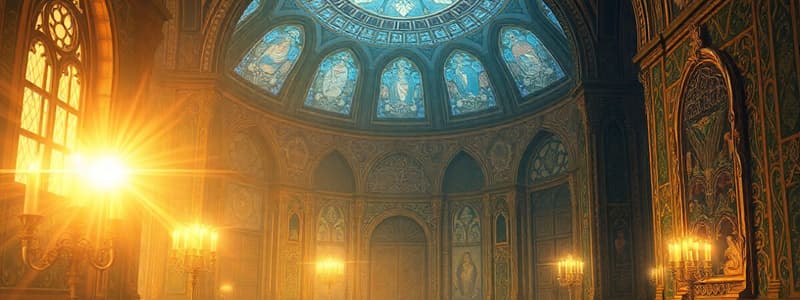Podcast
Questions and Answers
What type of image is created by a plane mirror?
What type of image is created by a plane mirror?
- Virtual and upright (correct)
- Converging and real
- Real and inverted
- Diminished in size
In which situation does light bend towards the normal?
In which situation does light bend towards the normal?
- When entering a more dense medium (correct)
- When it is incident at an angle of 45 degrees
- When it hits a reflective surface
- When entering a less dense medium
What is the focal length sign of a concave lens?
What is the focal length sign of a concave lens?
- Undetermined
- Zero
- Positive
- Negative (correct)
What happens to the speed of light when it moves from air to water?
What happens to the speed of light when it moves from air to water?
What is the relationship between the object distance and image distance for a plane mirror?
What is the relationship between the object distance and image distance for a plane mirror?
Which of the following properties does a virtual image NOT have?
Which of the following properties does a virtual image NOT have?
When calculating the index of refraction, what does 'c' represent?
When calculating the index of refraction, what does 'c' represent?
Which diagram is used to show the path of light through a lens?
Which diagram is used to show the path of light through a lens?
What part of the eye controls the size of the pupil?
What part of the eye controls the size of the pupil?
Which type of lens is used to correct myopia?
Which type of lens is used to correct myopia?
What is the primary function of the ciliary muscle in the eye?
What is the primary function of the ciliary muscle in the eye?
Where does the light-sensitive detection occur in the eye?
Where does the light-sensitive detection occur in the eye?
Which type of cell in the retina is responsible for color vision?
Which type of cell in the retina is responsible for color vision?
What happens to light entering the eye through the cornea?
What happens to light entering the eye through the cornea?
What visual issue occurs when an image forms beyond the retina?
What visual issue occurs when an image forms beyond the retina?
What is the role of the optic nerve in the human eye?
What is the role of the optic nerve in the human eye?
Flashcards
Plane Mirror Image Characteristics
Plane Mirror Image Characteristics
Plane mirrors create images that are the same size, upright, and the same distance from the mirror as the object. These images are virtual, appearing behind the mirror.
Convex Mirror Image Characteristics
Convex Mirror Image Characteristics
Convex mirrors create smaller, upright, and virtual images. The image is located behind the mirror.
Refraction
Refraction
The bending of light as it passes from one medium to another, with the bend determined by the change in speed.
Refraction (more optically dense)
Refraction (more optically dense)
Signup and view all the flashcards
Refraction (less optically dense)
Refraction (less optically dense)
Signup and view all the flashcards
Index of Refraction
Index of Refraction
Signup and view all the flashcards
Converging Lens
Converging Lens
Signup and view all the flashcards
Diverging Lens
Diverging Lens
Signup and view all the flashcards
Myopia
Myopia
Signup and view all the flashcards
Hyperopia
Hyperopia
Signup and view all the flashcards
Cornea
Cornea
Signup and view all the flashcards
Pupil
Pupil
Signup and view all the flashcards
Iris
Iris
Signup and view all the flashcards
Lens
Lens
Signup and view all the flashcards
Retina
Retina
Signup and view all the flashcards
Ciliary Muscle
Ciliary Muscle
Signup and view all the flashcards
Study Notes
Optics Review
- This review covers visible light, mirrors, refraction, lenses, the eye, and problems related to these topics.
Key Topics
- Visible Light: Includes the study of mirrors, ray diagrams, and formulas.
- Mirrors: Focuses on ray diagrams and formulas. Covers plane mirrors and their image characteristics. Also discusses convex mirrors.
- Refraction: Discusses the behavior of light when it moves between different mediums, including ray diagrams and formulas.
- Lenses: Covers ray diagrams, formulas, and the types of lenses (convex and concave).
- The Eye: Examines the parts of the human eye, the path of light into the eye, and how the eye focuses light. Includes discussions of common vision problems like myopia and hyperopia.
Plane Mirror
- A plane mirror creates an image that is the same size and upright as the original object.
- The image is located the same distance from the mirror as the original object.
- The image is virtual, meaning it appears behind the mirror.
Plane Mirror Image Characteristics
- Size: The image is the same size as the object.
- Attitude: The image is upright (same orientation as the object).
- Location: The image is the same distance from the mirror as the object.
- Type: The image is virtual.
Convex Mirrors
- The focal point (F) and the center of curvature (C) for a convex mirror are inside/behind the mirror.
Convex Mirror Question
- A convex mirror with a focal length of 0.9 m has an object 2.5 m from the mirror and 0.40m high.
- Students need to calculate the image distance and image height.
Refraction
-
Medium: Another word for material.
-
Incident Ray: The incoming light ray.
-
Refracted Ray: The light ray that exits the new medium.
-
Normal: A line drawn perpendicular to the surface of the medium where the incident ray hits.
-
Angle of Incidence: The angle between the incident ray and the normal.
-
Angle of Refraction: The angle between the refracted ray and the normal.
-
When light moves to a denser medium it bends towards the normal.
-
When light moves to a less dense medium it bends away from the normal.
Refraction Calculations
- An example problem provides the speed of light in sodium chloride and asks for the index of refraction.
- Formulas for refraction calculations are provided.
Types of Lenses
- Two general types of lenses: convex (converging) and concave (diverging).
- A convex lens is thicker in the middle than at the edges.
- A concave lens is thinner in the middle than at the edges.
Ray Diagrams
- Ray diagrams for both convex and concave lenses are explained. Use of the SALT rules for drawing and analyzing images are discussed.
Sign Rules for Lens Calculations
- Sign rules are crucial for determining the proper signs for the focal length, image distance, and image height in lens calculations; different signs indicate different positions and orientations.
Parts of the Human Eye
- Cornea: Transparent outer layer that refracts light.
- Iris: Colored part; controls the size of the pupil.
- Pupil: Hole in the iris; allows light to pass through.
- Lens: Flexible lens that refracts and focuses light.
- Ciliary Muscle: Adjusts the shape of the lens.
- Retina: Inner lining containing light-sensitive cells (rods and cones).
- Vitreous Humor: Jelly-like substance filling the eye.
- Sclera: Outer white part of the eye.
Path of Light into the Eye
- Light enters through the cornea, is refracted into the pupil, and passed through to the lens.
The Eye (Lens)
- The lens is a transparent, flexible, convex lens.
- It refracts and focuses light onto the retina.
- The ciliary muscle adjusts the lens’ shape for proper focusing.
The Eye (Retina)
- The retina is the light-sensitive lining at the back of the eye.
- Photoreceptors (rods and cones) detect light and send signals to the optic nerve to form an image.
Myopia
- Light is not focused correctly by the lens, causing the image to fall in front of the retina.
- Corrected using a diverging (concave) lens.
Hyperopia
- Light is not focused correctly by the lens, causing the image to fall behind the retina.
- Corrected using a converging (convex) lens.
Studying That Suits You
Use AI to generate personalized quizzes and flashcards to suit your learning preferences.




